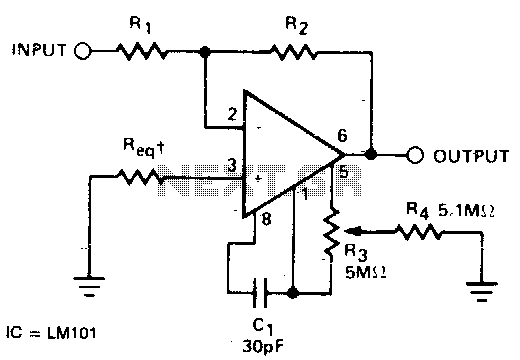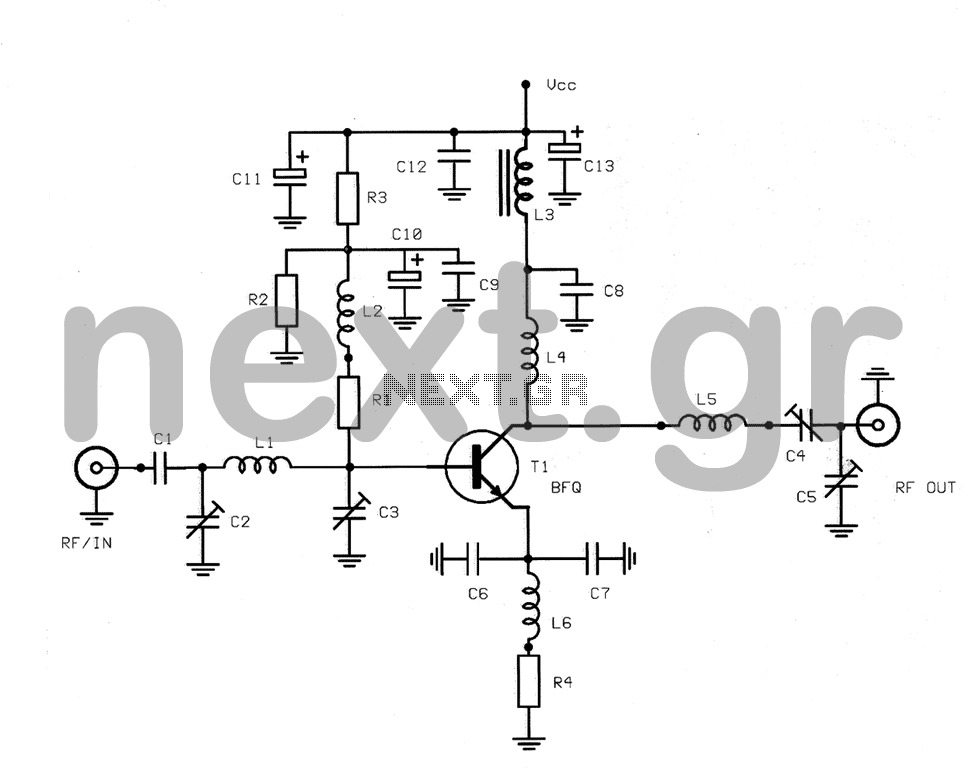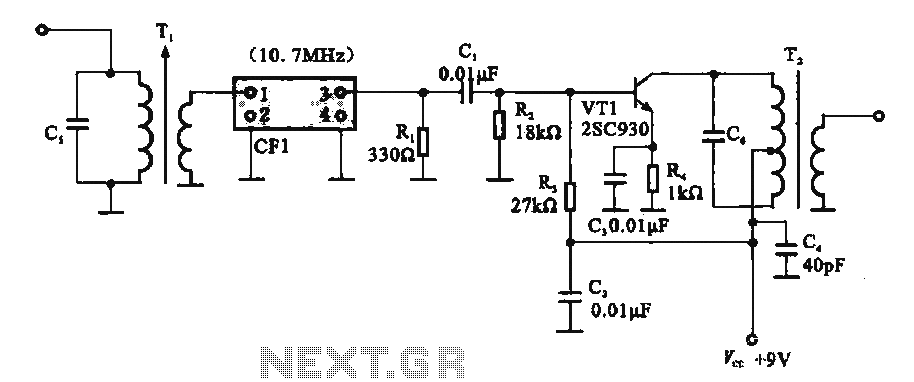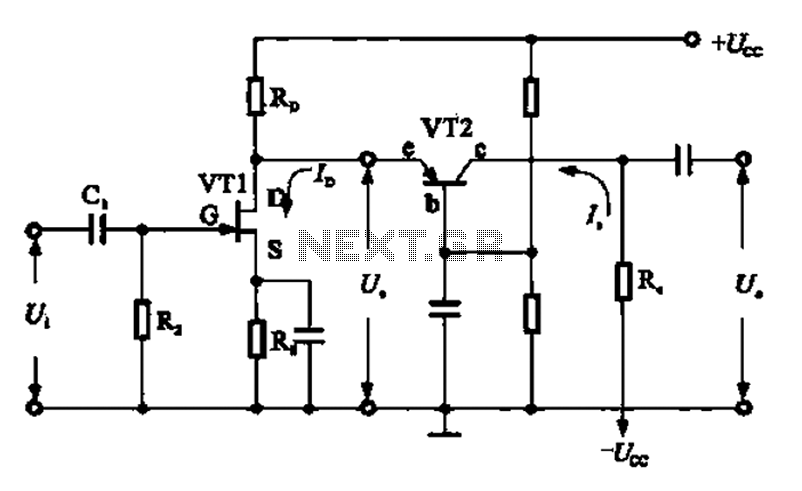
60W Guitar Amplifier
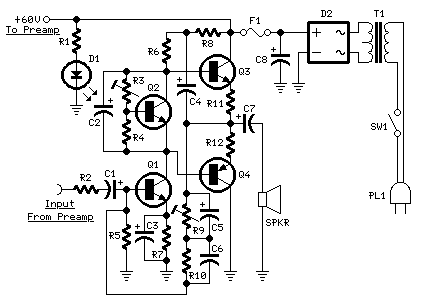
This design utilizes a well-established circuit topology for the power amplifier, employing a single-rail supply of approximately 60V and capacitor coupling for the speaker(s). The benefits for a guitar amplifier include a straightforward circuitry design, even for relatively high power outputs, along with an inherent level of loudspeaker protection due to capacitor C8, which prevents the voltage supply from reaching the loudspeakers in the event of output transistor failure. The preamplifier is powered by the same 60V rails as the power amplifier, enabling the implementation of a two-transistor gain block capable of delivering around 20V RMS output, which provides a high input overload capability. The listed Darlington transistor types may be oversized for this design; alternatives such as MJ11014 (Q3) and MJ11013 (Q4) or TIP142 (Q3) and TIP147 (Q4) can be used. Diodes D1 and D2 can be any Schottky-barrier types. With these components, the harmonic modifier operation will be more aggressive. Conversely, using two common 1N4148 silicon diodes for D1 and D2 will result in a softer harmonic modifier operation. In all configurations where Darlington transistors are employed as output devices, it is crucial that the sensing transistor (Q2) is in close thermal contact with the output transistors. Thus, a TO-126 case transistor type was selected for easy mounting on the heatsink, positioned closely to the output pair. Resistor R9 must be adjusted to measure approximately half the voltage supply from the positive lead of C7 to ground. Optimal settings can be achieved using an oscilloscope to ensure symmetrical clipping of the output waveform at maximum output power.
The described circuit topology is a classic design for a guitar amplifier, leveraging the advantages of a single-rail power supply for simplicity and reliability. The use of capacitor coupling allows for effective isolation between the amplifier stage and the loudspeaker, which is essential for protecting the speaker from potential damage during fault conditions.
The preamplifier section, which operates from the same 60V rail, plays a crucial role in the overall performance of the amplifier by providing sufficient gain while maintaining a high input overload capability. This feature is particularly important for guitar amplifiers, where signal dynamics can fluctuate significantly.
The choice of output transistors is critical. While the original design suggests using Darlington pairs, which are known for their high current gain, alternative transistors such as MJ11014 and MJ11013 or TIP142 and TIP147 provide sufficient performance without the potential drawbacks of over-specification. The use of Schottky-barrier diodes for D1 and D2 is advantageous due to their fast switching characteristics, but the softer 1N4148 diodes offer a different tonal quality that may be desirable depending on the application.
Thermal management is a vital aspect of this design. The placement of the sensing transistor (Q2) in close proximity to the output transistors ensures accurate temperature sensing and protection, which is essential for maintaining performance and reliability during operation. The selected TO-126 case allows for effective heat dissipation, which is crucial for the longevity of the output devices.
Finally, the adjustment of resistor R9 is a necessary step in the calibration process, ensuring that the amplifier operates within its optimal parameters. Using an oscilloscope to achieve symmetrical clipping at maximum output power is an effective method for fine-tuning the amplifier's performance, allowing for a balance between power and fidelity that is essential for high-quality audio reproduction in guitar amplifiers.This design adopts a well established circuit topology for the power amplifier, using a single-rail supply of about 60V and capacitor-coupling for the speaker(s). The advantages for a guitar amplifier are the very simple circuitry, even for comparatively high power outputs, and a certain built-in degree of loudspeaker protection, due to capacitor
C8, preventing the voltage supply to be conveyed into loudspeakers in case of output transistors` failure. The preamp is powered by the same 60V rails as the power amplifier, allowing to implement a two-transistors gain-block capable of delivering about 20V RMS output.
This provides a very high input overload capability. The Darlington transistor types listed could be too over sized for such a design. You can substitute them with MJ11014 (Q3) and MJ11013 (Q4) or TIP142 (Q3) and TIP147 (Q4). D1 and D2 can be any Schottky-barrier diode types. With these devices, the harmonic modifier operation will be hard. Using for D1 and D2 two common 1N4148 silicon diodes, the harmonic modifier operation will be softer. In all cases where Darlington transistors are used as the output devices it is essential that the sensing transistor (Q2) should be in as close thermal contact with the output transistors as possible.
Therefore a TO126-case transistor type was chosen for easy bolting on the heatsink, very close to the output pair. R9 must be trimmed in order to measure about half the voltage supply from the positive lead of C7 and ground.
A better setting can be done using an oscilloscope, in order to obtain a symmetrical clipping of the output waveform at maximum output power. 🔗 External reference
The described circuit topology is a classic design for a guitar amplifier, leveraging the advantages of a single-rail power supply for simplicity and reliability. The use of capacitor coupling allows for effective isolation between the amplifier stage and the loudspeaker, which is essential for protecting the speaker from potential damage during fault conditions.
The preamplifier section, which operates from the same 60V rail, plays a crucial role in the overall performance of the amplifier by providing sufficient gain while maintaining a high input overload capability. This feature is particularly important for guitar amplifiers, where signal dynamics can fluctuate significantly.
The choice of output transistors is critical. While the original design suggests using Darlington pairs, which are known for their high current gain, alternative transistors such as MJ11014 and MJ11013 or TIP142 and TIP147 provide sufficient performance without the potential drawbacks of over-specification. The use of Schottky-barrier diodes for D1 and D2 is advantageous due to their fast switching characteristics, but the softer 1N4148 diodes offer a different tonal quality that may be desirable depending on the application.
Thermal management is a vital aspect of this design. The placement of the sensing transistor (Q2) in close proximity to the output transistors ensures accurate temperature sensing and protection, which is essential for maintaining performance and reliability during operation. The selected TO-126 case allows for effective heat dissipation, which is crucial for the longevity of the output devices.
Finally, the adjustment of resistor R9 is a necessary step in the calibration process, ensuring that the amplifier operates within its optimal parameters. Using an oscilloscope to achieve symmetrical clipping at maximum output power is an effective method for fine-tuning the amplifier's performance, allowing for a balance between power and fidelity that is essential for high-quality audio reproduction in guitar amplifiers.This design adopts a well established circuit topology for the power amplifier, using a single-rail supply of about 60V and capacitor-coupling for the speaker(s). The advantages for a guitar amplifier are the very simple circuitry, even for comparatively high power outputs, and a certain built-in degree of loudspeaker protection, due to capacitor
C8, preventing the voltage supply to be conveyed into loudspeakers in case of output transistors` failure. The preamp is powered by the same 60V rails as the power amplifier, allowing to implement a two-transistors gain-block capable of delivering about 20V RMS output.
This provides a very high input overload capability. The Darlington transistor types listed could be too over sized for such a design. You can substitute them with MJ11014 (Q3) and MJ11013 (Q4) or TIP142 (Q3) and TIP147 (Q4). D1 and D2 can be any Schottky-barrier diode types. With these devices, the harmonic modifier operation will be hard. Using for D1 and D2 two common 1N4148 silicon diodes, the harmonic modifier operation will be softer. In all cases where Darlington transistors are used as the output devices it is essential that the sensing transistor (Q2) should be in as close thermal contact with the output transistors as possible.
Therefore a TO126-case transistor type was chosen for easy bolting on the heatsink, very close to the output pair. R9 must be trimmed in order to measure about half the voltage supply from the positive lead of C7 and ground.
A better setting can be done using an oscilloscope, in order to obtain a symmetrical clipping of the output waveform at maximum output power. 🔗 External reference

